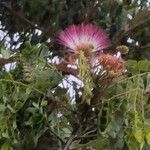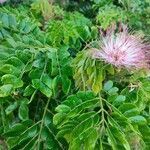Trees, 10-25 m tall. Branchlets puberulent to tomentose. Petiole 15-40 cm; pinnae 3-5(or 6) pairs, to 15 cm; glands at junctions of pinnae and leaflets; leaflets 3-8 pairs per pinna, asymmetrically oblong, 2-4 × 1-1.8 cm, abaxially pubescent, adaxially shiny, base half rounded, half truncate, apex rounded or obtuse, often emarginate and mucronulate. Heads 1-5, together axillary, 5-6 cm in diam.; peduncles 5-6 cm. Marginal flowers pedicellate; calyx funnel-shaped, ca. 6 mm; corolla red or yellowish red, ca. 1.2 cm; stamens white at base, purple toward apex, ca. 3.5 cm; staminal tube shorter than corolla tube. Central flowers sessile; corolla to 1.2 cm; staminal tube longer than corolla. Legume black, oblong, compressed, 10-20 × 1.2-2.5 cm, sutures thickened, septate between seeds. Seeds brown, ellipsoidal, ca. 8 × 5 mm. Fl. Aug-Sep, fr. Dec.
Tree to 25 m tall, velvety in most parts. Leaves: axes with sessile glands at insertion of pinnae and smaller ones at leaflet pairs; pinnae 3-9-jugate, oblanceolate-oblong. Leaflets 2-10-jugate, pairs per pinnae progressively fewer towards lamina base, oval (basal) to inequilaterally oblong or obovate and obtuse (apical), 1.5-4.5 cm long, 1-2.5 cm wide, basal pairs smaller, glabrous above, velutinous beneath. Inflorescences fasciculate in apical axils; peduncles 4.5-10 cm long. Flowers with pedicels 2-3 mm long; calyx 5-9 mm long; corolla 10-16 mm long. Pod narrowly oblong, 15-22 cm long, 15-23 mm wide, woody, minutely puberulous. Seeds elliptic to oblong, biconvex, 8-12 mm long, 5-6.5 mm wide, 4-5 mm thick.




